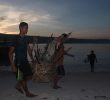III. ESTIMATING JI�S SIZE AND STRENGTH
Trying to estimate JI�s current size is necessarily something of a guessing game but it is clear that the organisation retains a committed membership, spread across the Indonesian archipelago from Aceh to Flores. The following analysis is based on information from JI�s geographic subdivisions (wakalah) and interviews suggesting relative size of those units. Repeatedly, for example, Crisis Group was told that the Solo wakalah is the largest; that Central Java and East Java follow; and that Lampung comes fourth. If it is known that Lampung in 2003 had 150 members, it can be assumed Central and East Java had more. If an educated guess can be made about Central Java�s strength, the figure for the Solo wakalah will be higher. It is far from an exact science but such calculations help in arriving at rough figures.
It is another guessing game entirely to take figures from 2004 or 2005 and estimate whether membership is falling or rising. But it is known that extraordinary loyalty � and occasionally fear � engendered by the oath-taking process (bai�at) binds new members to their teachers. The men administering the oath are not just higher in the organisational hierarchy; they are also people with religious and jihadi credentials. Bonds are not easily broken, even after three or four years of no contact with fellow JI members. Individuals may become inactive but they rarely take a conscious decision to leave the jama�ah, and if a superior asks a favour, it is very difficult to say no. The hundreds of arrests since the first Bali bombs may have disrupted the organisation less than originally assumed, although ideological differences over tactics and strategy are profound.
Most JI members do not agree with the actions of Noordin Top, the man responsible for the major bombings in Jakarta and Bali since 2003, although many feel an ongoing obligation to help him hide from police. But rejection of his tactics does not make the JI mainstream �moderate� in any conventional sense of the term. Its cost-benefit analysis may have militated against hitting Western targets on Java, but it clearly supported the Poso violence. Noordin-style attacks generated public outrage and were also expensive. The Australian embassy attack in September 2004 cost about $7,800; the assassination of the head of the Central Sulawesi Protestant Church in October 2006 cost about $20.
The mainstream is not necessarily opposed to bomb attacks in principle. If Muslim casualties could be avoided, religious justification were clear and benefits outweighed disadvantages, many would drop their objections. That JI retains such a large membership and is still recruiting should be a matter of concern, even as some leading figures in the anti-Noordin faction are quietly embraced (and sometimes funded) by officials anxious to encourage divisions in the organisation.
The fact remains that JI�s focus is on jihad and on the use of military tactics to achieve its objective of establishing a community where Islamic law can be practiced. If it were interested in non-military tactics, it could join with PKS or other legal parties interested in working through a democratic political system. But JI believes fundamentally that non-Muslims, Muslim apostates and other anti-Islamic forces seek to destroy Islam and will have to be confronted with physical force if a true Islamic community is to be established. That confrontation can also help expand the mass base. In this respect, many JI leaders saw ongoing jihad areas like Poso in Central Sulawesi as beneficial, whereas there is nothing to suggest that the Bali bombings or the Australian embassy attack had any recruitment value.










